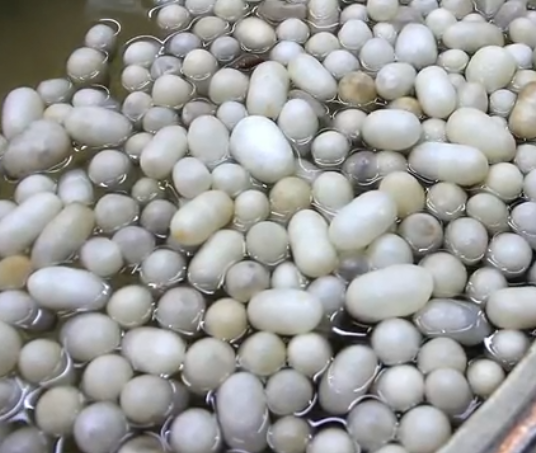Hydrolyzed Silk or Hydrolyzed silk powder is a compound of silk, silk proteins and contains acids that are interesting for the human body.

Its structure of amino acids is very similar to the natural moisturizing factor of the skin ph 5.6, easy to dissolve in water and has a strong affinity with the skin giving it shine, nourishment, softness and elasticity.
Raw materials used in production:
- Natural Silk: Primarily extracted from the cocoons of the silkworm.
- Hydrolyzing agents: Chemicals or enzymes used to break down the protein chains of silk during the hydrolysis process.
The industrial synthesis process takes place in different steps:
- Raw Material Collection - The primary raw material is natural silk, which is a protein fiber produced by the silkworm.
- Degumming - Before hydrolysis, silk is often degummed to remove sericin, another protein that surrounds the fibroin (the main protein in silk).
- Hydrolysis Process - The degummed silk is then subjected to hydrolysis, where it's broken down using water and specific enzymes or chemicals into smaller peptides and amino acids.
- Purification - The resulting hydrolyzed silk solution is then purified to remove any unwanted residues or by-products.
What it is used for and where
Cosmetics
- Antistatic agent. Static electricity build-up has a direct influence on products and causes electrostatic adsorption. The antistatic ingredient reduces static build-up and surface resistivity on the surface of the skin and hair.
- Hair conditioning agent. A significant number of ingredients with specific and targeted purposes may co-exist in hair shampoo formulations: cleansers, conditioners, thickeners, matting agents, sequestering agents, fragrances, preservatives, special additives. However, the indispensable ingredients are the cleansers and conditioners as they are necessary and sufficient for hair cleansing and manageability. The others act as commercial and non-essential auxiliaries such as: appearance, fragrance, colouring, etc. Hair conditioning agents have the task of increasing shine, manageability and volume, and reducing static electricity, especially after treatments such as colouring, ironing, waving, drying and brushing. They are, in practice, dispersants that may contain cationic surfactants, thickeners, emollients, polymers. The typology of hair conditioning agents includes: intensive conditioners, instant conditioners, thickening conditioners, drying conditioners. They can perform their task generally accompanied by other different ingredients.
- Humectant. Hygroscopic compound used to minimise water loss in the skin and to prevent it from drying out by facilitating faster and greater absorption of water into the stratum corneum of the epidermis. The epidermis is the most superficial of the three layers that make up human skin (epidermis, dermis and hypodermis) and is the layer that maintains hydration in all three layers. In turn, the epidermis is composed of five layers: horny, the most superficial, granular, spinous, shiny, and basal. Humectants have the ability to retain the water they attract from the air in the stratum corneum and have the function of moisturising the skin. They are best used before emollients, which are oil-based.
- Skin conditioning agent. It is the mainstay of topical skin treatment as it has the function of restoring, increasing or improving skin tolerance to external factors, including melanocyte tolerance. The most important function of the conditioning agent is to prevent skin dehydration, but the subject is rather complex and involves emollients and humectants that can be added in the formulation.
Safety
The Expert Panel for Cosmetic Ingredient Safety (Panel) reviewed the safety of Hydrolyzed Silk and 9 other silk protein ingredients, which function primarily as skin and hair conditioning agents and bulking agents in cosmetic products. The Panel reviewed relevant data relating to the safety of these ingredients and concluded that 8 ingredients are safe in the present practices of use and concentration in cosmetics, as described in this safety assessment, but that the available data are insufficient for determining the safety of 2 silk protein ingredients in cosmetic products, MEA-Hydrolyzed Silk and Silkworm Cocoon Extract (1).
CAS 96690-41-4
EC number 306-235-8
References______________________________________________________
(1) Johnson W Jr, Bergfeld WF, Belsito DV, Hill RA, Klaassen CD, Liebler DC, Marks JG Jr, Shank RC, Slaga TJ, Snyder PW, Gill LJ, Heldreth B. Safety Assessment of Silk Protein Ingredients as Used in Cosmetics. Int J Toxicol. 2020 Nov/Dec;39(3_suppl):127S-144S. doi: 10.1177/1091581820966953.


![]() Hydrolyzed silk powder
Hydrolyzed silk powder